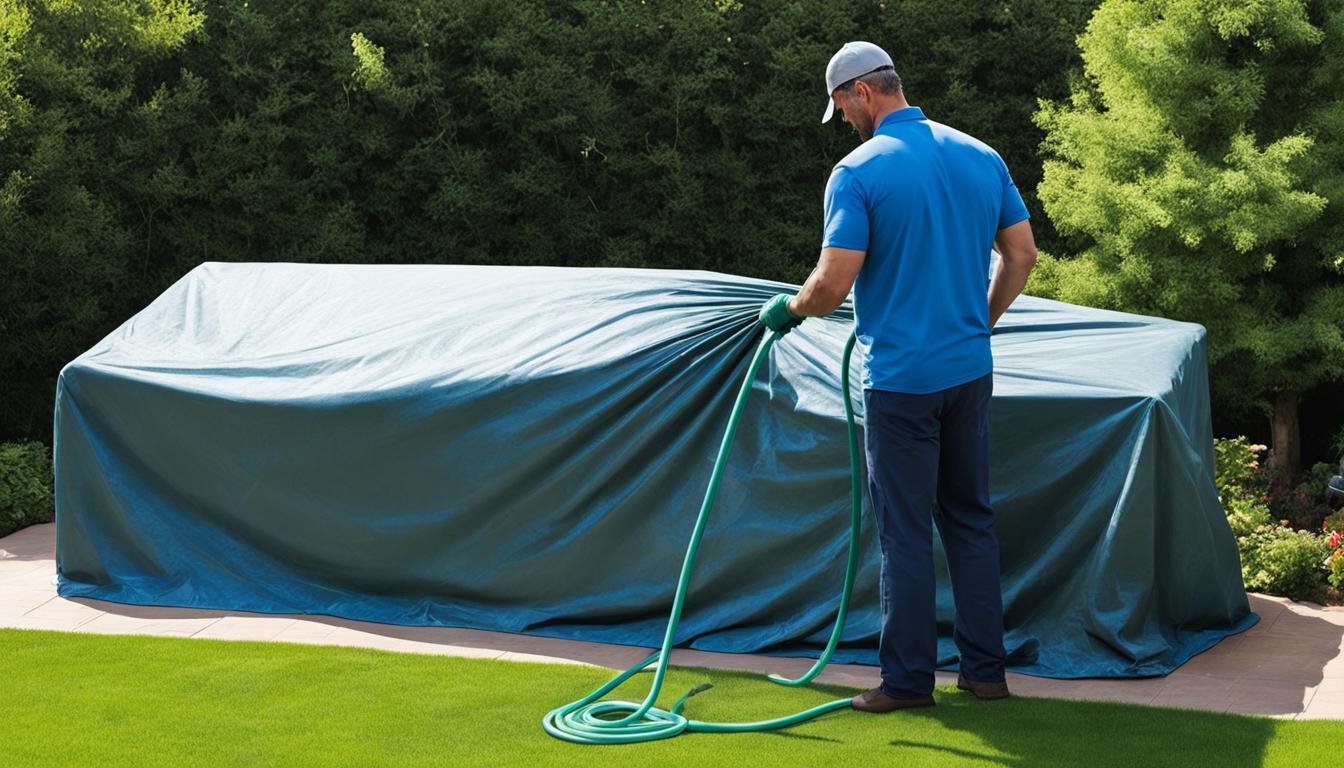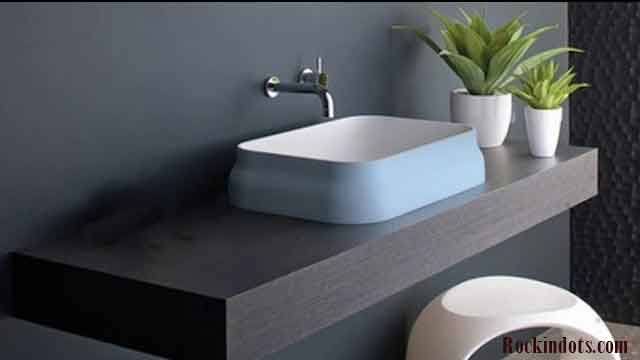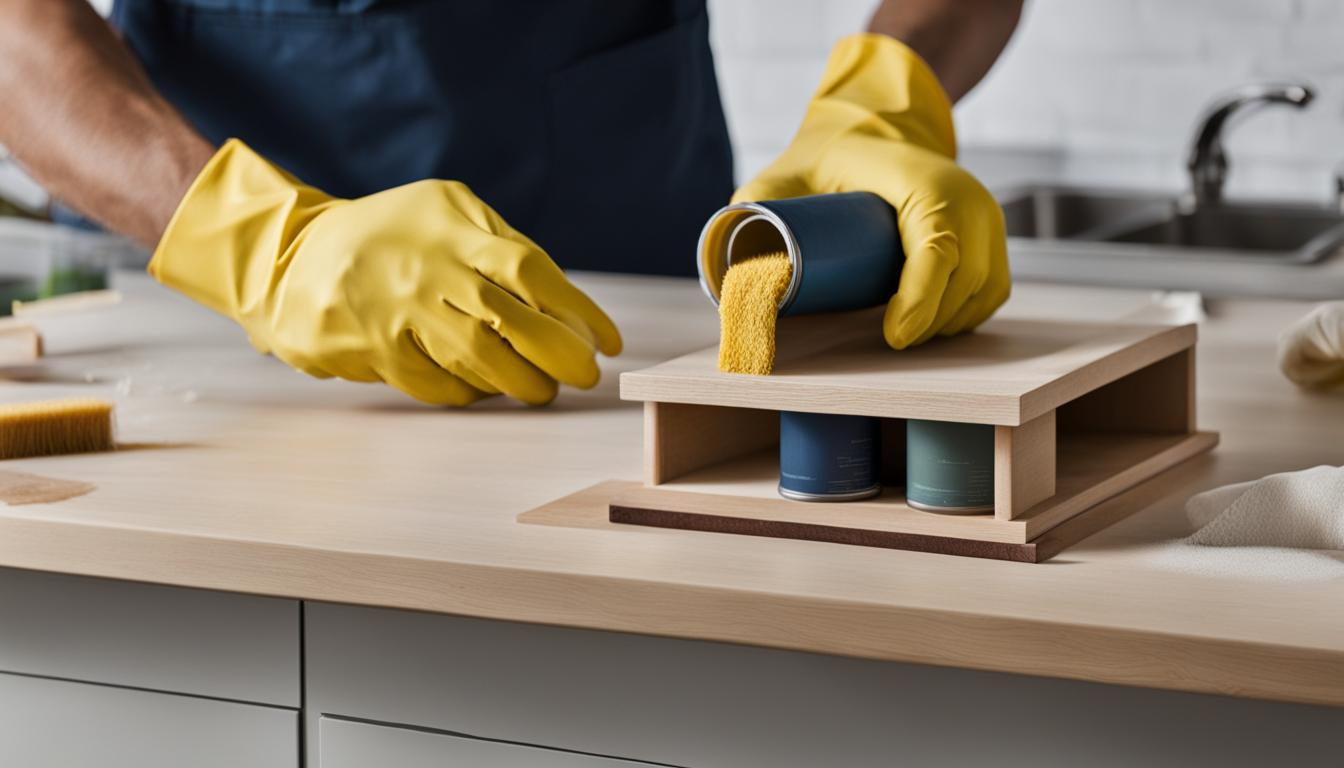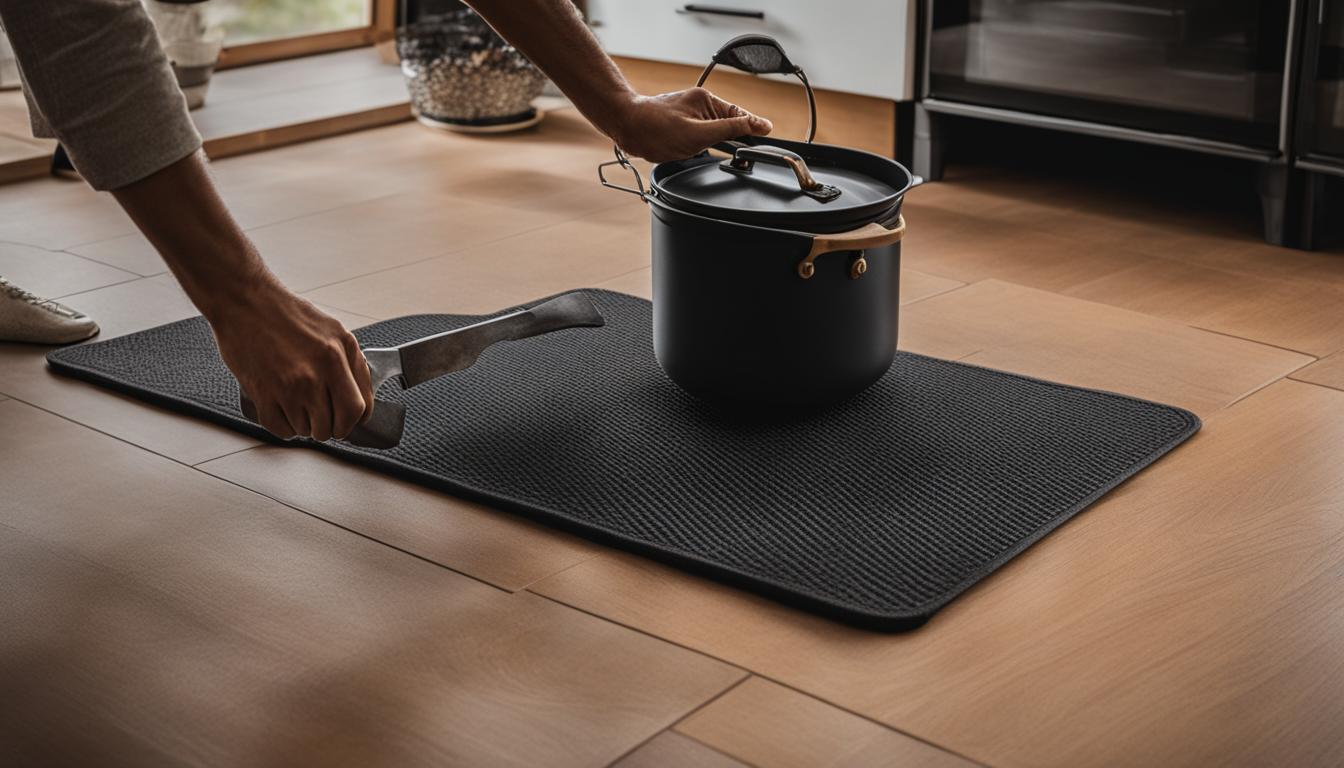Welcome to my easy guide on how to keep your outdoor furniture covers clean and well-maintained. Outdoor furniture covers serve an essential purpose by protecting your patio furniture from the elements, dust, and debris.
However, they can accumulate dirt, stains, and other types of grime. Cleaning your outdoor furniture covers regularly ensures their longevity and keeps them looking their best.
Contents
Key Takeaways:
- Regularly cleaning outdoor furniture covers is necessary to maintain their effectiveness and prolong their lifespan.
- It is crucial to understand the different types of outdoor furniture covers and their specific cleaning requirements.
- Mild soap and warm water are adequate for cleaning polyester, nylon, and vinyl covers.
- Different cleaning solutions must address specific stains such as mold and mildew, rust, bird droppings, grass, tree sap, and sunscreen.
- Proper storage and preventive measures, like using protective sprays and avoiding water pooling, can help preserve the quality of your outdoor furniture covers.
Understanding Different Types of Outdoor Furniture Covers
When it comes to protecting your outdoor furniture, investing in high-quality covers is essential. However, with so many options available on the market, choosing the right one for your needs can be overwhelming.
This section will explain the different types of outdoor furniture covers and their unique characteristics.
Polyester Outdoor Furniture Covers
Polyester covers are popular among homeowners due to their durability and resistance to various outdoor elements.
They withstand shrinking, wrinkles, stretching, and mildew growth. In addition, polyester covers are fade-resistant and provide excellent UV protection for your furniture.
Nylon Outdoor Furniture Covers
Although unexpected, nylon is a robust synthetic material that offers excellent protection for your outdoor furniture.
One of the advantages of nylon covers is that they are safe for machine washing, making the cleaning process hassle-free. Nylon covers are also resistant to fading and offer good water repellency.
Vinyl Outdoor Furniture Covers
Vinyl covers are a popular choice for their durability and glossy appearance. They offer exceptional protection against dirt, dust, sunlight, and rain.
It is important to note that cleaning vinyl covers should be turned inside out to preserve their shine and prevent any potential damage.
Polypropylene Outdoor Furniture Covers
Polypropylene covers are affordable for those looking to protect their outdoor furniture on a budget.
While they may be less durable than other materials, they offer decent protection against environmental factors. Hand washing is recommended for polypropylene covers to ensure their longevity.
Each type of outdoor furniture cover has its advantages and disadvantages, so it’s essential to consider your specific needs and preferences.
Now that you understand the different types of outdoor furniture covers, you can make an informed decision and protect your furniture effectively.
| Type of Cover | Advantages | Disadvantages |
|---|---|---|
| Polyester | Durable, resistant to shrinking, wrinkles, stretching, and mildew | It may be pricier compared to other materials |
| Nylon | Strong, safe for machine washing, fade-resistant | Less water repellency compared to other materials |
| Vinyl | Durable, glossy appearance, excellent dirt and dust protection | Should be turned inside out for cleaning |
| Polypropylene | Affordable, decent protection against environmental factors | Less stable compared to other materials |
Cleaning Your Outdoor Furniture Covers
Cleaning your outdoor furniture covers is a simple process that can be done with essential household items. By following these easy steps, you’ll be able to keep your covers looking fresh and clean.
Cleaning Solutions:
For polyester, nylon, or vinyl covers, a solution of mild soap and warm water is highly effective. This gentle mixture helps to remove dirt, grime, and stains without damaging the fabric. Mix a small amount of mild soap with warm water in a bucket or basin.
Tip: Avoid using harsh chemicals or abrasive cleaners as they can cause discoloration or damage to the cover material.
Gently scrub the covers with a soft brush or cloth using the soapy water. Pay close attention to any areas that are heavily soiled. For stubborn stains, let the soapy water soak into the cover for a few minutes before scrubbing.
After scrubbing, rinse the covers thoroughly with clean water to remove any remaining soap residue.
Make sure to rinse both the front and back of the covers to ensure complete cleanliness. Use a hose or bucket of water for rinsing, and avoid using high-pressure washers as they may damage the covers.
Tip: When rinsing, make sure the water flows in the same direction as the cover’s seams to avoid any potential damage or leakage.
Once rinsed, allow the covers to air dry completely. Hang or lay them flat in a well-ventilated area, avoiding direct sunlight. This will help prevent any moisture from being trapped, which can lead to mold or mildew growth.
Special Care for Wood Covers:
If your outdoor furniture covers are made of wood, using an oil-based soap specifically designed for wood care is essential. This soap helps nourish and protect the wood, keeping it looking beautiful for years.
Apply the oil-based soap onto a soft cloth or sponge and gently wipe down the wood covers. Be sure to follow the manufacturer’s instructions for the soap you use to achieve the best results.
Hand Washing with Gentle Detergent:
Some outdoor furniture covers should not be machine-washed. Hand washing with a mild detergent is the preferred method in such cases. Fill a basin or sink with lukewarm water and add a small amount of gentle detergent.
Tip: Check the care label on your covers for specific washing instructions and any recommended detergents.
Immerse the covers into the soapy water and gently agitate them with your hands. Please pay attention to any stained or soiled areas and gently rub them to remove the dirt. Once cleaned, rinse the covers thoroughly with clean water and allow them to air dry completely before storing or reusing.
Regular cleaning of your outdoor furniture covers keeps them looking fresh and prolongs their lifespan. Using the right cleaning solutions and methods, you can maintain the beauty and functionality of your covers season after season.

Removing Tough Stains and Addressing Common Issues
Outdoor furniture covers are designed to protect your patio furniture from various weather elements and daily wear and tear. However, these covers can accumulate tough stains that require special attention over time.
In this section, I will guide you on effectively removing stains from your outdoor furniture covers and address common issues such as mold and mildew, rust and bird droppings, grass, tree sap, and sunscreen stains.
Removing Mold and Mildew Stains
Mold and mildew stains are unsightly and can lead to unpleasant odors. To tackle these stains, create a solution using a mixture of bleach and mild dish detergent. Wear protective gloves and apply the solution to the affected areas using a spray bottle.
Allow the solution to sit briefly before rinsing it off with clean water. Finally, expose the covers to sunlight to ensure thorough drying and prevent mold or mildew growth.
Dealing with Rust and Bird Droppings
Rust and bird droppings can leave stubborn stains on your outdoor furniture covers. Combine baking soda with soapy water to remove these stains to create a gentle cleaning solution. Gently scrub the stained areas using a soft brush or cloth, focusing on the tarnished spots.
Rinse the covers thoroughly with clean water, allowing them to air dry completely. This method will help restore the cleanliness and appearance of your covers.
Tackling Grass, Tree Sap, and Sunscreen Stains
Grass stains, tree sap, and sunscreen stains are common issues that outdoor furniture covers may encounter. Each type of stain requires a tailored approach for effective removal:
- Grass stains: Begin by removing any excess grass from the covers. Then, apply a stain remover directly to the stained areas and gently scrub with a soft brush. Rinse thoroughly with water and allow the covers to air dry.
- Tree sap stains: Apply rubbing alcohol to a clean cloth and gently dab the sap stains. Avoid rubbing vigorously to prevent the spreading of the sap. Once the stains are lifted, rinse the covers with water and allow them to dry naturally.
- Sunscreen stains: Pre-treat the stained areas with water and mild detergent. Gently scrub the stains using a soft brush or cloth. Rinse with clean water and allow the covers to air dry.
Following these stain removal techniques, you can ensure your outdoor furniture covers remain clean and free from unsightly stains.
Regular maintenance and prompt treatment of stains will help prolong the lifespan of your covers, keeping them in excellent condition for years to come.
Conclusion
Cleaning and maintaining your outdoor furniture covers is crucial for ensuring their longevity and effectiveness. Regularly cleaning your covers and following the manufacturer’s instructions can keep them pristine for years to come.
Additionally, protective sprays can help extend the life of the covers and provide extra resistance against weather elements.
Proper storage is another critical factor in maintaining your outdoor furniture covers. Folding and storing them in a waterproof container or using a cover storage bag will protect them from dust, moisture, and potential damage. This will help to prevent fading, tearing, and other forms of wear and tear.
One common issue with outdoor furniture covers is water pooling. To prevent this, consider using inflatable airbags or ensuring the covers are properly secured. This will allow rainwater to drain off the covers quickly, preventing the formation of stagnant pools that can potentially damage the covers.
By implementing these outdoor furniture cover maintenance tips, storing them properly, and taking measures to prevent water pooling, you can maintain the quality and durability of your outdoor furniture covers, ensuring they continue to protect your furniture and enhance the overall appeal of your outdoor space.
FAQ
How often should outdoor furniture covers be cleaned?
Outdoor furniture covers should be cleaned regularly, ideally every 1-2 months, to prevent dirt and stains from building up.
Can I machine wash all types of outdoor furniture covers?
No, not all types can be machine-washed. Polyester, nylon, and vinyl covers can be machine washed, while polypropylene covers should be hand washed.
What cleaning solution is best for outdoor furniture covers?
A solution of mild soap and warm water is adequate for most polyester, nylon, or vinyl covers. Wood covers can be cleaned with oil-based soap.
How can I remove tough stains from outdoor furniture covers?
Mold and mildew stains can be treated with bleach and mild dish detergent, while rust and bird droppings can be scrubbed with baking soda and soapy water.
How should I store my outdoor furniture covers?
To prevent damage, fold the covers and store them in a waterproof container or use a cover storage bag. It’s also essential to ensure the covers are properly secured to prevent water pooling.





